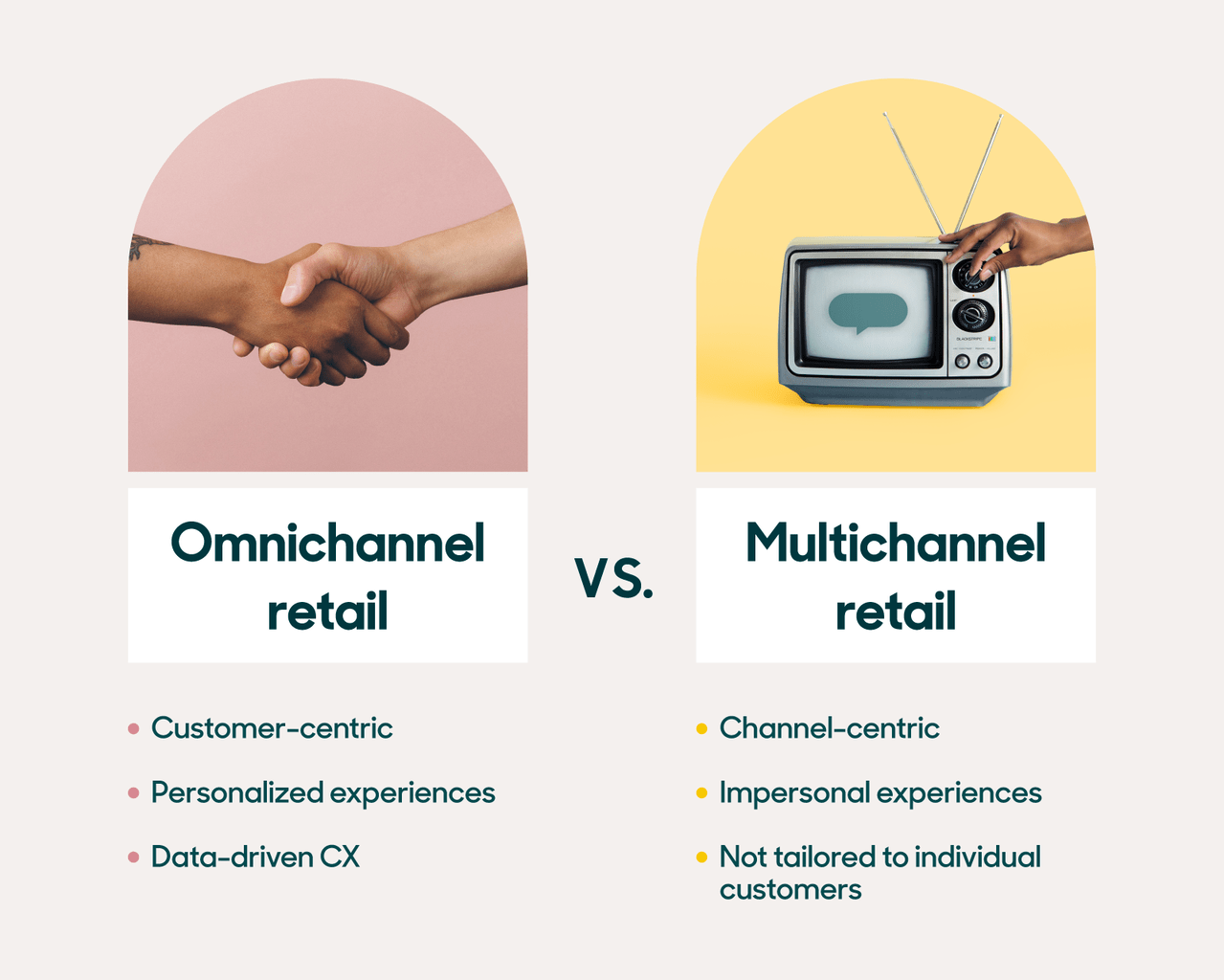Article • 11 min read
What is omnichannel retail? Definition, examples, and trends
Omnichannel retailing is a customer experience strategy that lets customers interact with a brand on the channels of their choice and enjoy connected, personalized experiences.
Av Erin Hueffner, Staff Writer, Retail Industry
Senast uppdaterad March 27, 2024
Today, customers expect to have flexible and seamless shopping experiences. This is where omnichannel retail comes in. This increasingly vital retail customer experience helps customers communicate with businesses on the channel of their choice and allows for connected conversations.
According to the Zendesk Customer Experience Trends Report 2023, 70 percent of consumers say that a seamless experience will lead to them purchasing more from a company, and 64 percent will spend more money if businesses resolve their issues on the channel they’re currently using.
In this guide, learn more about omnichannel retailing, its benefits, upcoming trends, and how to craft an omnichannel strategy.
What is omnichannel retailing?
Omnichannel retailing is a customer experience strategy that lets customers interact with a brand on their preferred channels. Customers can switch between channels seamlessly, as the retailer retains their information as they move from channel to channel. This results in more tailored and personalized experiences for customers.
Omnichannel vs. multichannel in retail

Omnichannel and multichannel, although seemingly similar, have different approaches in the retail world. Multichannel is a simple way of saying your brand operates on multiple channels, such as:
Social media
Phone
Email
Chat
Omnichannel in retail differs in that it connects those channels for a customer experience and conversation that can seamlessly move between channels.
Another layer that makes up omnichannel is customer context—this is important to ensure that customer service representatives have access to customer details across channels, tools, and systems. In doing so, reps and store associates are able to personalize the conversation regardless of how a customer reaches out.
For example, a business can integrate its customer relationship management (CRM) software with an app like Shopify to have order details upfront. Additionally, a chatbot can let a rep know that a customer has a loaded shopping cart, so the customer doesn’t have to repeat themselves when contacting support. Service reps can also upsell and cross-sell by sending personalized recommendations for a higher-tier or related product upon checkout.
Chupi took advantage of omnichannel by integrating Zendesk into its operations. Zendesk helped Chupi’s customer care agents provide consistent and personalized service by pulling customer information—like DMs from Instagram and Facebook—into one platform. Chupi saw a 300 percent increase in care-based sales, resulting in one million euros in sales directly from the customer care team.
Benefits of omnichannel retail
Incorporating omnichannel retail into your business’ operations can enable you to improve the customer engagement and experience, meet shoppers where they are, and more. Learn about the benefits of omnichannel retail below.
A retailer’s guide to getting omnichannel customer service right
Download this retail ebook to find out why you need an omnichannel customer service strategy today.
Examples of omnichannel in retail

Is your business considering moving to a retail omnichannel strategy? For inspiration to get started, check out these great examples of retail omnichannel in action.
In Good Taste
In Good Taste, a popular wine retailer, took its strategy a step further when it partnered with Zendesk to help consolidate its email and chat conversations in a centralized platform.
Sixty-five percent of tickets come in through chat, so the brand found a way to make the experience more unique by training their agents to provide customers with wine pairing and recommendations.
By using Zendesk, In Good Taste saw a 97.1% CSAT score, 85% ticket resolution time, and 29% faster chat reply time.
Why it works: With the unique chat capability, customers can receive wine advice in real time and enjoy a meaningful experience with agents.
Boxycharm
Boxycharm, a community-first beauty subscription service, leverages powerful integrations, social messaging, and sophisticated automation as part of its omnichannel retail strategy.
For example, the company utilizes third-party apps to assist with answering Instagram direct messages, tracking support tickets, and maintaining its in-house data warehouse—all with the help of Zendesk.
Thanks to the Zendesk integration and third-party app capabilities, Boxycharm met customers where they were by providing them with additional ways to reach out.
In return, the Boxycharm team saw its CSAT rise by 10 points, its first response time drop by 66%, and more than 60% of its email volume deflected with automated responses.
Why it works: Customers can contact Boxycharm on the platform that feels the most convenient to them.
Wine.com
Wine.com, another wine retailer, leverages omnichannel shopping by providing its customers with personalized service. Wine.com offers a live chat run by non-commissioned wine connoisseurs who are dedicated to helping customers select the best wine for their personal tastes and needs.
Zendesk integrations with Twitter, Facebook, and Instagram allow customers to reach out through their preferred social media channel.
Though it offers many communication channels, Wine.com can easily track customer tickets across platforms and consolidate chats and emails to prevent duplicate tickets and responses.
As a result, Wine.com achieved a 55% decrease in first reply time along with a 91% CSAT score. This means the company is able to drive loyalty with personalized experiences—efficiently and at scale.
Why it works: Wine.com adheres to a customer-centric approach and boosts customer loyalty by incorporating personalized service.
Corkcicle
Corkcicle is a sustainable hydration product retailer that partners with Zendesk to boost its omnichannel retail strategy by incorporating the use of chat, text, and help centers.
The chat and text capability allows customers to access live support to get answers quickly and easily. On top of that, customers have self-service options through a help center, which reduces the volume of tickets that come through.
After implementing Zendesk, the Corkcicle support team delivered superior customer experiences and achieved a 100% increase in first reply time despite a double-digit increase in sales.
Why it works: Customers can conveniently find answers on their own time through help centers and also reach out to support agents through chat and text.
Omnichannel retail trends for 2023

If you want to add to your retail digital presence, omnichannel retail is a good place to start, and you’ll want to be up to date with the latest capabilities to incorporate into your strategy. Here are some important omnichannel retail trends to watch for in 2023.
Shopatainment
Shopatainment is a form of live social selling where video is leveraged over photos to sell products and services.
For example, many brands have been using Instagram Live to sell products in real time. With this strategy, brands must be prepared to respond to DMs and questions that come up during the live selling process.
The metaverse
The metaverse is another trend to watch for in the upcoming months and can be a key element to an omnichannel retail strategy. The metaverse lets businesses provide their shoppers with a virtual reality experience through virtual storefronts or gaming platforms.
With the rise of virtual spaces, the customer experience must be immersive and follow a shopper through whichever virtual space they’re connecting in.
AI experiences
AI experiences in retail are becoming more evolved and seamless. According to our CX Trends Report, 73 percent of customers expect more interactions with AI in their daily life. AI-powered bots and automation improve customer service quality by allowing a business to:
Scale support, eliminate wait times, and reduce repetitive work
Auto-route tickets and apply shortcuts to reply to common inquiries
Recognize data, speech, and specific patterns in support tickets and use that info to make connections and determine the best course of action
Reduce shopping cart abandonment with frictionless buying by giving customers answers in a timely manner
Leveraging AI can also ensure customers get answers faster and decrease the volume of tickets by letting them help themselves. You can deflect common requests with a conversational bot 24/7 and free up agents’ time, so they can focus on more complex tasks that require a human touch.
How to build your omnichannel retail strategy
Looking to further enrich the omnichannel customer experience? Below are seven steps to help you build a robust strategy.
1. Split your customers into segments
The first step in building your strategy is to segment your customers. The goal here is to figure out who your audience is and how you can personalize your offerings rather than implementing a one-size-fits-all approach. You can segment customers by:
Income
Gender
Geographic region
Age
Values
Past interactions
Tip: If you’re using a CRM platform, it should already have audience demographics available.
2. Look into which channel each segment uses
Once you have your segments, look into the top-used channels for each one. They could include:
Chat
Email
Phone
Social media direct messages
For instance, you may find that customers ages 20 to 30 use the chat feature the most to reach out to your team, and they’re also the top purchasers. In that case, you would want to consider focusing your efforts on personalizing the chat experience.
As you do this, ensure you track key performance indicators and omnichannel analytics to gather more insights into how you can leverage channel use among your target audience.
3. Create a customer journey map
After looking into your buyers and their preferred channels, you’ll need to create a customer journey map. This tells you the “how” and “why” behind a customer’s decisions and experiences.
A customer journey map tracks things like:
- Touchpoints: These are the interactions that customers have with a company, whether they happen via social media, chat, etc.
- Pain points and opportunities: Gaps in the customer experience can pop up while mapping the customer journey and surface issues that weren’t noticed before.
- Actions and emotions: This information tells you how a customer feels during the journey. These emotions can lead to churn or a purchase. For example, if a user is interested in buying a product but has trouble with the checkout process, they may look for an alternative instead.
4. Provide cross-channel customer support
Since your omnichannel shopping experience boasts a multichannel experience, you’ll also want to build a cross-channel support team to handle requests on every platform. An omnichannel customer service team can:
Deliver more personalized experiences
- Help identify opportunities to satisfy customers
Increase revenue
Reduce churn
Resolve issues more quickly
With cross-channel support, teams can effectively transfer conversations from web chat to a chat app, from an email to SMS, or from social media to the phone, making it easier for agents and customers alike.
5. Incorporate integrations
Prioritize incorporating different integrations as part of your retail omnichannel strategy. For example, you may want an app that helps track inventory, one that supports direct messages from social media, and one that tracks support tickets.
These integrations can also help provide a unified and real-time view of data and operations.
6. Add automation
Automation helps you streamline operations and deliver a well-rounded support experience. This is where the use of AI comes in—with AI, your team can:
Leverage chatbots to deflect simple questions
Deliver more personalized experiences through product recommendations
- Automate follow-up and thank-you messages to help boost customer retention and loyalty
7. Test regularly
There is no one-size-fits-all approach to an omnichannel retail experience, so it’s important to test and experiment with different actions to see which fits your business the best.
For example, you can test different content, formatting, email subject lines, templates, and more.
Make testing a regular habit to ensure your strategy adapts to the ever-evolving retail landscape.
Deliver a strong omnichannel retail experience
With the rapidly changing and growing world of retail, it’s important to stay on top of the trends and incorporate the omnichannel retail experience into your strategy. To create a strong, well-rounded experience, pair your strategy with a top-notch customer service solution that sets your teams up for success.

